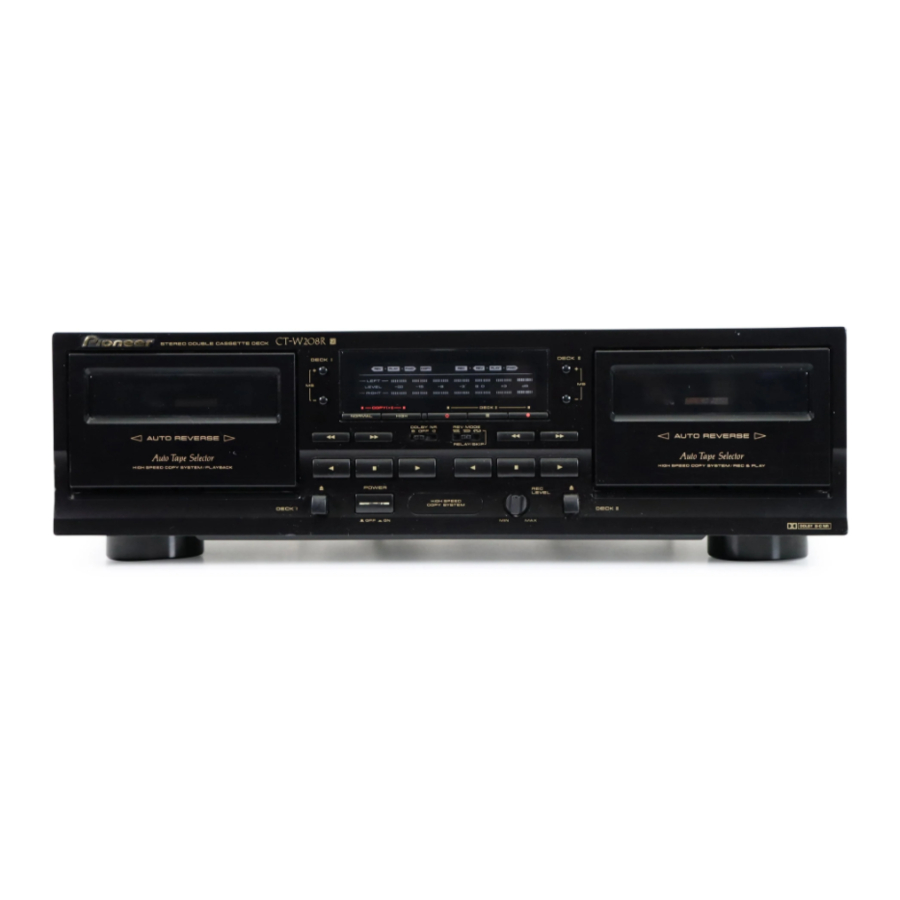Pioneer CT-W208R - Dual Cassette Deck Operating Instructions Manual - Page 4
Browse online or download pdf Operating Instructions Manual for Receiver Pioneer CT-W208R - Dual Cassette Deck. Pioneer CT-W208R - Dual Cassette Deck 32 pages. Stereo double
Also for Pioneer CT-W208R - Dual Cassette Deck: Operating Instructions Manual (20 pages), Catalog (10 pages), Specifications (1 pages), Service Manual (34 pages), Service Manual (34 pages)

INSTALLATION
When installing the deck, avoid locations with
high temperatures or humidity, and make sure
that the deck receives adequate ventilation.
7
Do not install the deck in locations subject to direct
sunlight, or near a space heater or other heating
device, as this may cause damage to the finish or
internal parts.
7
Malfunctions may also result if the deck is installed
in an excessively humid or dusty location. Avoid
installing the deck next to kitchen counters or other
locations subject to oily smoke or humidity.
7
If the deck is placed directly on top of an amplifier,
it may pick up humming or other noise. Also, if the
amplifier generates a large amount of heat, the deck
may malfunction.
7
If the deck is located near a television set, it may
pick up interference noise, which will be recorded
as a whistling sound on the tape. If this happens,
move the deck further away from the television set
or turn the television set off when operating the
deck.
7
Do not place a cloth over the deck, or block the
ventilation slots in any way. The ventilation slots on
this deck are necessary to keep internal parts cool.
If they are blocked, the deck may malfunction.
CONDENSATION
When the deck is moved from a cold location to a
warm location, or when the temperature of the room
changes suddenly, condensation may form on the
mechanical parts. This can adversely affect the
performance of the deck. To prevent this, wait for about
one hour to allow the deck to adjust to the room
temperature. To prevent condensation when heating a
room, raise the temperature slowly.
4
En/Fr
INSTALLATION
Pour installer la platine, éviter les endroits
très chauds ou humides et s'assurer que la
platine est correctement ventilée.
7
Ne pas installer la platine dans un endroit en plein
soleil ou à proximité d'un dispositif de chauffage
qui pourrait affecter la finition extérieure et les pièces
internes.
7
Des dysfonctionnements peuvent se produire si la
platine est installée dans un endroit excessivement
humide ou poussiéreux. Eviter la proximité de
cuisines ou d'autres endroits où se dégagent des
vapeurs huileuses ou de l'humidité.
7
Si la platine est installée directement sur un
amplificateur, elle risque de capter un ronflement
ou d'autres parasites. En outre, la platine peut ne
pas fonctionner correctement si l'amplificateur
génère une forte chaleur.
7
Si la platine est placée près d'un téléviseur, elle
peut capter des interférences qui seront enregistrées
sous forme de sifflement sur la bande. Dans ce
cas, éloigner la platine du téléviseur ou couper
l'alimentation du téléviseur lors de l'utilisation de la
platine.
7
Ne recouvrez pas la platine d'une étoffe et ne
bouchez pas les fentes de ventilation. Ces fentes
sont nécessaires au refroidissement des pièces
internes. Si elles sont obturées, la platine risque de
ne pas fonctionner correctement.
CONDENSATION
Si la platine est transportée d'un endroit froid à un
endroit chaud, ou si la température de la pièce change
rapidement, de la condensation peut se former sur la
surface des pièces mécaniques et affecter les
performances de la platine. Dans un tel cas, attendre
environ une heure pour laisser la platine s'adapter à la
température de la pièce.
Pour èviter la formation de condensation lorsque vous
chauffez une pièce, augmentez lentement la
tempèrature.
